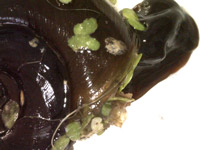Stereomicroscopes
Using a stereomicroscope you can look at a wide range of exciting biological samples that you can easily find in your garden or further afield. In this section we list a few examples of samples that we find either beautiful or interesting (usually both). But there are many more you could try – imagination is your limit!
- Insects
 Examples of common insects that look amazing under the stereomicroscope include, butterflies, moths, ladybirds and other beetles, flies and bumblebees.
Examples of common insects that look amazing under the stereomicroscope include, butterflies, moths, ladybirds and other beetles, flies and bumblebees.- Flowers
 We find that flowers offer one of the most beautiful microscopic images. They are also conveniently available from the garden or florists. You can look at a great variety of flowers – each will surprise you with something interesting and beautiful (perhaps even a mite!).
We find that flowers offer one of the most beautiful microscopic images. They are also conveniently available from the garden or florists. You can look at a great variety of flowers – each will surprise you with something interesting and beautiful (perhaps even a mite!).
Some types of leaves and bark also look interesting under a stereomicroscope.- Seeds
 Viewing seeds under the microscope if often surprising – they are very beautiful and complex. Some seeds are more interesting than others: we use beetroot, radish and courgette seeds, but there are certainly many more that look amazing. Get experimenting!
Viewing seeds under the microscope if often surprising – they are very beautiful and complex. Some seeds are more interesting than others: we use beetroot, radish and courgette seeds, but there are certainly many more that look amazing. Get experimenting!- Feathers
 Although not so easy to find, feathers are worth looking at with a stereomicroscope.
Although not so easy to find, feathers are worth looking at with a stereomicroscope.- Creepy crawlies
 Creepy crawlies might not look beautiful under a stereomicroscope to everyone, but they do look interesting. Look in your garden for worms, caterpillars, snails, spiders and slugs.
Creepy crawlies might not look beautiful under a stereomicroscope to everyone, but they do look interesting. Look in your garden for worms, caterpillars, snails, spiders and slugs.- Fingers and hair
 When children come across a stereomicroscope often the first thing they do is look at their fingertips and nails. This can sometimes cause a slightly unpleasant surprise but it is very interesting nonetheless. Hair is also worth looking at in stereomicroscope or compound microscope.
When children come across a stereomicroscope often the first thing they do is look at their fingertips and nails. This can sometimes cause a slightly unpleasant surprise but it is very interesting nonetheless. Hair is also worth looking at in stereomicroscope or compound microscope.

